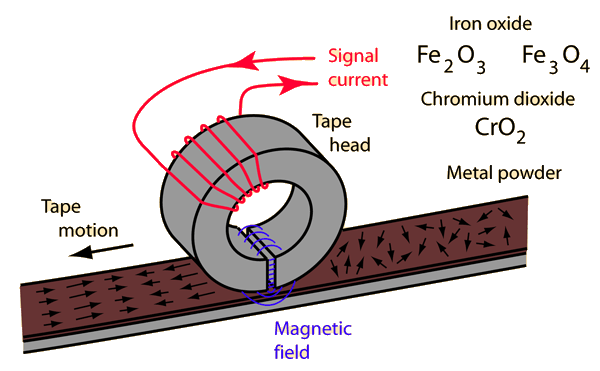Like vinyls and record players, cassette tapes are an older music technology intended for audio storage. Cassette tapes are even more obsolete compared to record players, but, who knows, perhaps in a few years it will become trendy to walk around listening to cassette players. Thinking of cassette tapes makes me remember listening to audiobooks such as Hank the Cowdog, or songs like Puff the Magic Dragon, as a kid.
The cassette tape uses magnetism to store and play music and really began a revolution on the storage of data. Previously, only external hard drives could be used to store large amounts of data on the computer, but these were generally even more expensive than the computer itself. The tape used in the cassette is a thin plastic coated with ferric oxide powder, an oxide of iron, which is ferromagnetic (Nave). When placed in a magnetic field, this iron oxide can become permanently magnetized. The tape can also be played on either side, A or B, so the cassette can be turned around to play more audio recordings. Each side of the tape has two channels for the right and left speaker, meaning there are four channels in total per tape in a cassette (Nave).

The cassette tape uses magnetism to store and play music and really began a revolution on the storage of data. Previously, only external hard drives could be used to store large amounts of data on the computer, but these were generally even more expensive than the computer itself. The tape used in the cassette is a thin plastic coated with ferric oxide powder, an oxide of iron, which is ferromagnetic (Nave). When placed in a magnetic field, this iron oxide can become permanently magnetized. The tape can also be played on either side, A or B, so the cassette can be turned around to play more audio recordings. Each side of the tape has two channels for the right and left speaker, meaning there are four channels in total per tape in a cassette (Nave).

Cassette Tape - Hyperphysics
The head of the cassette tape is also important. It is made of iron and contains a wire cable wrapped around it's top (Nave). As the film moves while being played in a cassette player, the tape moves below the head and its magnetic field generates a current in the coil. The magnetic signal in the cassette tape has transformed into an electrical signal. This current, which provides an analog signal, is then amplified and sent to the speakers of the cassette player (Nave).
Puff the Magic Dragon (Live) - Peter, Paul, & Mary
Owners of cassette tapes had to be careful to keep them away from magnetic fields, as this could remove the data stored within the tapes. Although they are now mostly unused by the majority of people, cassette tapes were one of the first products that allowed music to be mobile and integrate into peoples' lives.
References:
Nave, R. (N. D.). Magnetic Tape Recording. Retrieved from: http://hyperphysics.phy-astr.gsu.edu/hbase/Audio/tape2.html
Peter, Paul, & Mary. (2014). Puff the Magic Dragon. Retrieved from: https://www.youtube.com/watch?v=z15pxWUXvLY
A very well-written and interesting final post on cassette tapes. Yes, my sons frequently listened to books on tape while following along in the hard copy book when they were very young. Thank you for your excellent blog postings over the semester. I have enjoyed your posts immensely. Well done! JM
ReplyDelete